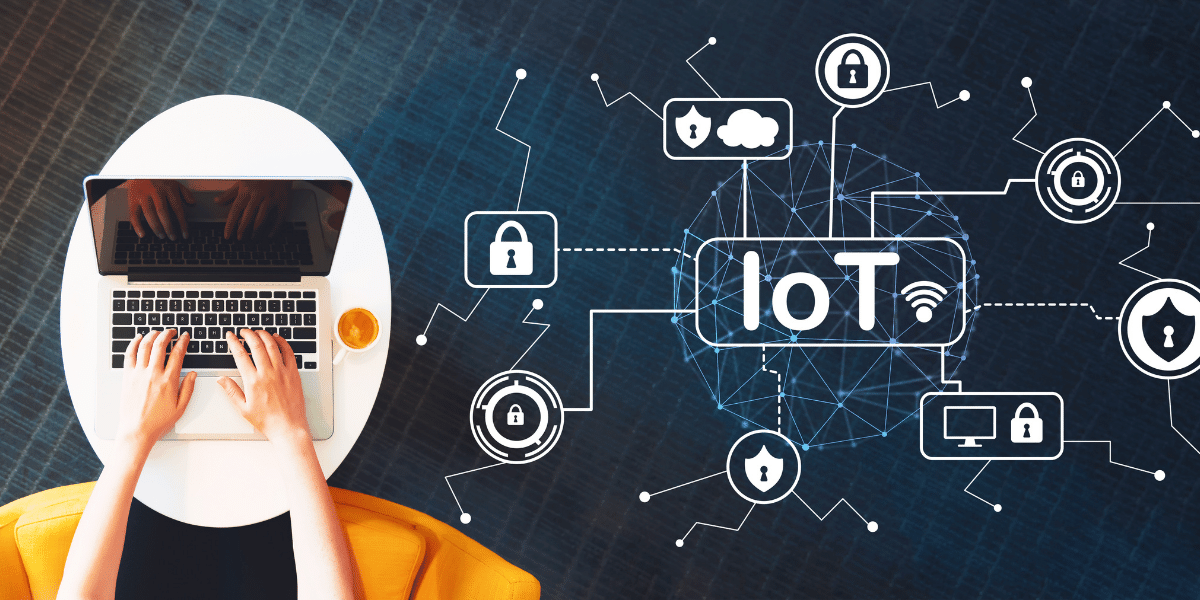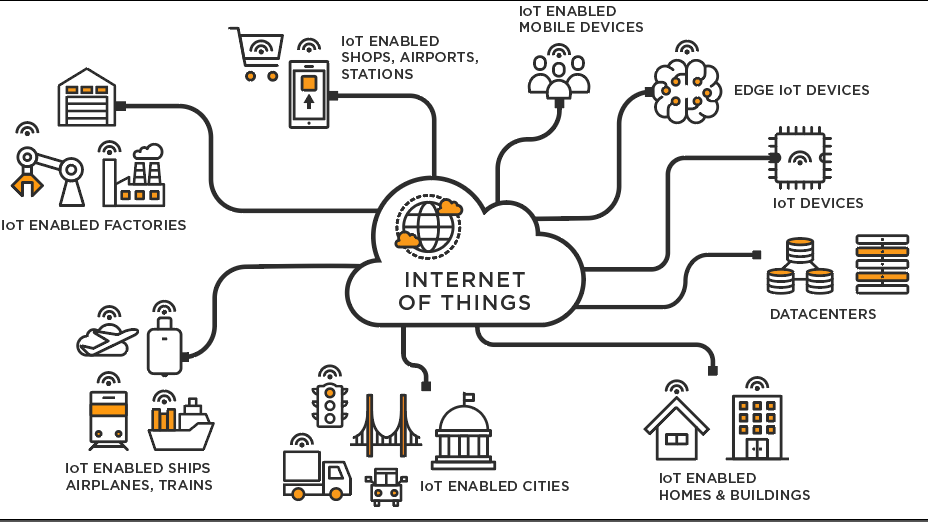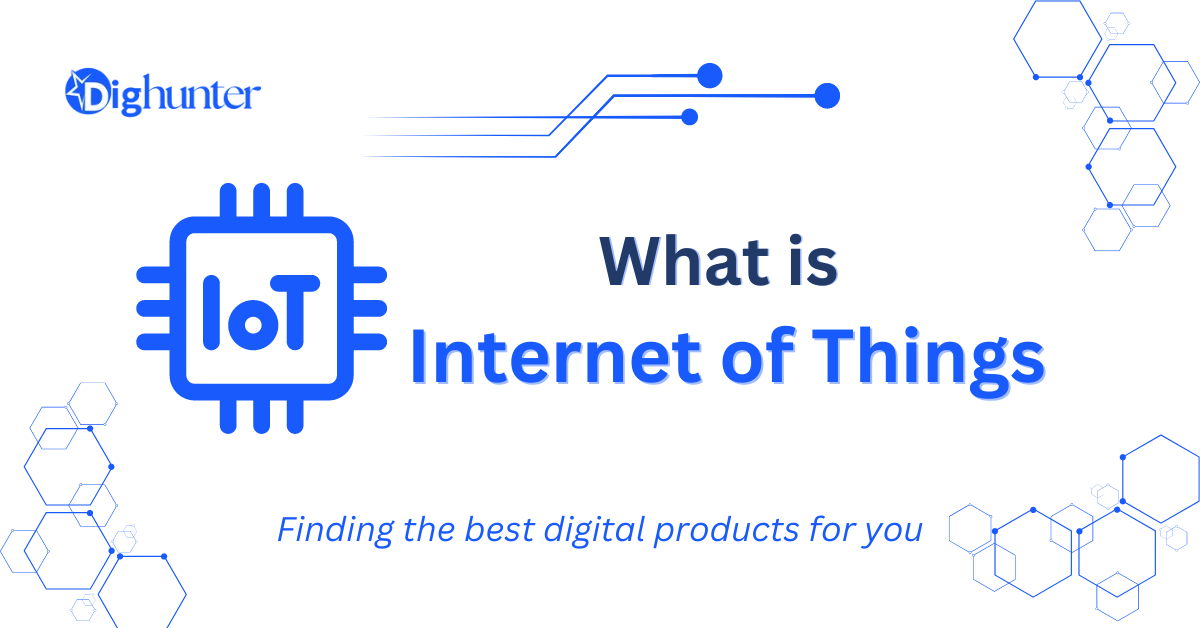The Internet of Things (IoT) connects everyday devices to the Internet, enabling data exchange and automation. This technology enhances convenience and efficiency.
IoT has revolutionized how we interact with technology. Smart homes, wearable devices, and connected cars are just a few examples. These devices communicate with each other, making daily tasks easier and more efficient. IoT’s applications extend to industries such as healthcare, agriculture, and manufacturing.
In healthcare, IoT devices monitor patient health in real-time, improving care. In agriculture, IoT sensors optimize irrigation and crop management. Manufacturing industries use IoT to enhance production processes and reduce downtime. This interconnected ecosystem of devices drives innovation and improves quality of life. Embracing IoT is essential for staying competitive in today’s digital world.
➡️What is IoT?
The Internet of Things (IoT) is changing our world. But what is IoT? It’s a network of physical devices connected to the internet. These devices collect and share data. IoT helps make our lives easier and smarter.
Key Components
IoT has several key components. Each plays a vital role in the system. Here are the main parts:
- Sensors and Devices: These gather data from the environment. For example, a thermostat senses temperature.
- Connectivity: Devices connect to the internet using Wi-Fi, Bluetooth, or other methods. This allows them to send and receive data.
- Data Processing: Once data is collected, it needs to be processed. This happens in the cloud or on local servers.
- User Interface: Users need a way to interact with the system. This could be an app or a website.
Let’s look at these components in a table:
| Component | Description |
|---|---|
| Sensors and Devices | Collects data from the environment |
| Connectivity | Links devices to the internet |
| Data Processing | Analyzes the collected data |
| User Interface | Allows user interaction |
How It Works
Understanding how IoT works is simple. Devices with sensors collect data. This data is then sent to the cloud.
Here’s a step-by-step process:
- Data Collection: Sensors gather data from their environment. For instance, a motion sensor detects movement.
- Data Transmission: The collected data is sent to the cloud. This happens through various connectivity options like Wi-Fi.
- Data Processing: In the cloud, the data is processed. This could mean analyzing temperature data to adjust a thermostat.
- User Interaction: Users can view and interact with the data. They might use an app to see their home’s temperature.
IoT makes life easier and smarter. It connects devices, collects data, and provides insights.

Credit: industlabs.com
➡️Applications
The Internet of Things (IoT) transforms how we live and work by connecting everyday devices to the internet. These connected devices can communicate, share data, and perform actions without human intervention. IoT has numerous applications that enhance efficiency, convenience, and safety across various sectors. Below, we explore some exciting applications of IoT.
Smart Homes
Smart homes use IoT to make living spaces more comfortable and efficient. By connecting home devices, smart homes offer automation and remote control. This technology can improve everyday life in several ways:
- Automated Lighting: Lights can turn on or off based on your presence.
- Smart Thermostats: Adjusts temperature based on your preferences and habits.
- Security Systems: Cameras, locks, and alarms can be controlled remotely.
- Voice Assistants: Control devices using voice commands.
Smart homes are not only about convenience. They also help in energy saving and security. Here is a simple table showing some popular smart home devices and their functions:
| Device | Function |
|---|---|
| Smart Bulbs | Adjust lighting remotely or automatically |
| Smart Plugs | Control appliances from your phone |
| Smart Doorbells | See and talk to visitors remotely |
| Smart Thermostats | Regulate home temperature efficiently |
Healthcare Innovations
IoT is revolutionizing healthcare with innovations that improve patient care and streamline medical processes. Here are some key applications:
- Wearable Devices: Track vital signs like heart rate and sleep patterns.
- Remote Monitoring: Doctors can monitor patients’ health data in real time.
- Smart Medical Devices: Devices like insulin pumps can deliver medication automatically.
- Telemedicine: Enables remote consultations and diagnoses.
These innovations enhance medical care, making it more efficient and accessible. For example, wearable devices can alert doctors to potential health issues before they become severe. Here is a table summarizing some IoT healthcare devices and their uses:
| Device | Use |
|---|---|
| Smartwatches | Track fitness and health metrics |
| Remote ECG Monitors | Monitor heart conditions remotely |
| Smart Inhalers | Monitor and manage asthma |
| Connected Contact Lenses | Measure glucose levels in tears |
These applications of IoT in healthcare are making a significant impact on patient outcomes and overall healthcare efficiency.
➡️Benefits of IOT
The Internet of Things (IoT) has revolutionized the way we live and work. By connecting devices and systems, IoT offers numerous benefits that enhance our daily lives and business operations. Here, we will explore the key benefits of IoT, focusing on efficiency improvements and cost savings.
Efficiency Improvements
IoT significantly boosts efficiency in various sectors. By connecting devices, systems, and people, it creates a seamless flow of information. This connectivity allows for real-time monitoring and management, which leads to enhanced productivity.
- Automation: IoT automates repetitive tasks, reducing human error and freeing up valuable time.
- Real-time data: Sensors collect real-time data, providing insights that help in making quick decisions.
- Predictive maintenance: IoT devices predict equipment failures before they happen, minimizing downtime.
| Sector | Efficiency Improvement |
|---|---|
| Manufacturing | Automated production lines and predictive maintenance |
| Healthcare | Remote patient monitoring and smart medical devices |
| Transportation | Optimized route planning and fleet management |
By implementing IoT, businesses and individuals can achieve higher efficiency, leading to better performance and outcomes.
Cost Savings
Another significant benefit of IoT is cost savings. By optimizing operations and reducing waste, IoT helps cut costs across various industries.
- Energy management: Smart devices monitor and control energy usage, reducing utility bills.
- Inventory management: IoT tracks inventory levels in real-time, minimizing overstock and stockouts.
- Resource optimization: Efficient use of resources leads to lower operational costs.
| Industry | Cost Saving Measure |
|---|---|
| Retail | Smart shelves and automated restocking |
| Agriculture | Precision farming and resource-efficient irrigation |
| Energy | Smart grids and energy-efficient appliances |
Implementing IoT not only improves efficiency but also results in substantial cost savings, making it a valuable investment for any industry.

Credit: www.youtube.com
➡️Challenges of IOT
The Internet of Things (IoT) is revolutionizing how we live and work. By connecting devices and sharing data, IoT creates smarter homes, cities, and industries. Despite its benefits, IoT faces significant challenges. These challenges can hinder its widespread adoption and effectiveness.
Security Concerns
Security is a major challenge in IoT. Connected devices can be vulnerable to cyber-attacks. Hackers can access sensitive data and disrupt services. Ensuring robust security is crucial for protecting users and data.
Here are some common security issues in IoT:
- Data Breaches: Unauthorized access to data stored on devices.
- Device Hijacking: Hackers taking control of devices.
- Weak Authentication: Poor password practices and lack of encryption.
A table highlighting common security concerns and their impacts:
| Security Concern | Impact |
|---|---|
| Data Breaches | Loss of sensitive information |
| Device Hijacking | Unauthorized control of devices |
| Weak Authentication | Easy access for hackers |
To mitigate these issues, manufacturers must integrate strong encryption, regular software updates, and multi-factor authentication. Users should also use strong, unique passwords and keep their devices updated.
Interoperability Issues
Interoperability is another significant challenge in IoT. Devices from different manufacturers often struggle to communicate. This lack of compatibility can limit the functionality of IoT ecosystems.
Here are some factors contributing to interoperability issues:
- Proprietary Protocols: Unique communication standards that are not universally supported.
- Diverse Hardware: Different types of devices with varying capabilities.
- Software Incompatibilities: Different operating systems and applications.
A table showing common interoperability issues and their consequences:
| Interoperability Issue | Consequence |
|---|---|
| Proprietary Protocols | Limited device communication |
| Diverse Hardware | Inconsistent performance |
| Software Incompatibilities | Reduced functionality |
To address these issues, adopting universal standards and promoting open-source protocols are essential. Manufacturers should collaborate to ensure devices can work seamlessly together. This will enhance the overall user experience and drive the growth of IoT.
➡️Future Trends of IOT
The Internet of Things (IoT) is changing how we live and work. Devices connect and communicate, making life easier. The future of IoT holds exciting trends. These trends include AI integration and the impact of 5G. Let’s explore these future trends in detail.
Ai Integration
Artificial Intelligence (AI) is merging with IoT. This AI integration makes devices smarter and more efficient. Smart homes, for example, use AI to learn user preferences and automate tasks. AI helps in predictive maintenance, reducing downtime and costs.
Here are some key points on AI integration with IoT:
- Data Analysis: AI analyzes data from IoT devices, providing valuable insights.
- Automation: AI automates repetitive tasks, saving time and effort.
- Security: AI enhances security by detecting anomalies and threats.
AI and IoT together create a powerful combination. They improve user experience and operational efficiency. For instance, AI-powered cameras can recognize faces and objects, enhancing security systems.
Here’s a table showing the benefits of AI integration with IoT:
| Benefit | Description |
|---|---|
| Enhanced Decision Making | AI processes data quickly, aiding in better decisions. |
| Improved Efficiency | Automation reduces manual intervention, boosting productivity. |
| Cost Savings | Predictive maintenance lowers repair costs. |
AI integration is a key trend in IoT’s future. It makes devices smarter and more user-friendly.
5g Impact
5G technology is revolutionizing IoT. It offers faster speeds and lower latency. This means IoT devices can communicate in real-time. 5G impact on IoT is significant, enabling new applications and services.
Key impacts of 5G on IoT include:
- Faster Data Transfer: 5G speeds up data transfer between devices.
- Lower Latency: Devices respond instantly, enhancing real-time applications.
- Increased Connectivity: More devices can connect simultaneously without network congestion.
5G supports smart cities, autonomous vehicles, and remote healthcare. For example, autonomous cars require real-time data to navigate safely. 5G makes this possible with its low latency.
Here’s a table showing the advantages of 5G for IoT:
| Advantage | Description |
|---|---|
| Enhanced Connectivity | More devices can connect without slowing down. |
| Real-Time Communication | Devices communicate instantly, improving performance. |
| Scalability | Networks handle more devices efficiently. |
5G technology will transform IoT, making it more efficient and responsive. The future of IoT looks promising with 5G.

Credit: businesstech.bus.umich.edu
➡️Industries Transformed
The Internet of Things (IoT) has revolutionized various industries by connecting devices and enabling seamless data exchange. This technological advancement has significantly improved efficiency, productivity, and decision-making processes across multiple sectors. Two industries that have experienced remarkable transformations are manufacturing and agriculture.
Manufacturing
The manufacturing industry has seen a dramatic shift with the adoption of IoT. IoT devices have enhanced production lines and reduced downtime. Factories now operate smarter and faster.
Key benefits in manufacturing:
- Predictive maintenance: Sensors monitor equipment health, predicting failures before they happen.
- Real-time monitoring: IoT devices provide real-time data on production processes, improving efficiency.
- Quality control: Automated systems detect defects, ensuring high-quality products.
Here’s a table showcasing IoT’s impact on manufacturing:
| Aspect | Traditional Method | IoT Integration |
|---|---|---|
| Maintenance | Scheduled checks | Predictive maintenance |
| Monitoring | Manual checks | Real-time data |
| Quality Control | Post-production checks | Automated detection |
Smart factories now utilize IoT to optimize resource usage and improve safety standards. Workers benefit from improved working conditions and fewer accidents. IoT in manufacturing leads to reduced costs and higher productivity.
Agriculture
Agriculture has also embraced IoT, leading to what is known as smart farming. Farmers use IoT devices to monitor soil conditions, weather patterns, and crop health.
Key benefits in agriculture:
- Precision farming: Sensors provide detailed information about soil and crops, allowing for precise resource allocation.
- Automated irrigation: IoT systems automate watering schedules, conserving water and ensuring optimal crop growth.
- Livestock monitoring: Wearable devices track animal health, improving livestock management.
Here’s a table showcasing IoT’s impact on agriculture:
| Aspect | Traditional Method | IoT Integration |
|---|---|---|
| Irrigation | Manual watering | Automated systems |
| Crop Monitoring | Visual inspection | Sensors and drones |
| Livestock Health | Periodic checks | Wearable devices |
Smart farming increases crop yields and reduces environmental impact. Farmers can make informed decisions based on real-time data. IoT in agriculture leads to more sustainable and efficient farming practices.
➡️IoT Protocols
The Internet of Things (IoT) connects everyday devices to the internet. These devices communicate using specific rules called protocols. IoT protocols ensure data moves smoothly and securely between devices. Two key protocols are MQTT and CoAP. Let’s explore these in detail.
Mqtt
MQTT stands for Message Queuing Telemetry Transport. It is lightweight and efficient. This makes it ideal for IoT devices with limited power and memory.
MQTT works on a publish/subscribe model. Devices called publishers send messages to a server called a broker. Other devices, known as subscribers, receive these messages from the broker.
- Low bandwidth usage: MQTT uses minimal data, making it perfect for low-speed networks.
- Quality of Service (QoS) levels: MQTT offers three QoS levels to ensure message delivery.
- Persistent sessions: MQTT can store session data, allowing devices to reconnect without data loss.
MQTT is widely used in various applications, including:
| Application | Description |
|---|---|
| Smart Home | Controls lights, thermostats, and security systems. |
| Healthcare | Monitors patient health data in real-time. |
| Industrial IoT | Tracks machinery and optimizes production processes. |
COAP
CoAP stands for Constrained Application Protocol. It is designed for devices with limited resources. CoAP uses a client/server model similar to HTTP but is much lighter.
- Low overhead: CoAP uses compact binary headers, reducing data size.
- RESTful architecture: CoAP supports CRUD operations (Create, Read, Update, Delete).
- Reliable message delivery: CoAP uses confirmable and non-confirmable messages.
- Smart Energy: Managing smart meters and energy grids.
- Environmental Monitoring: Tracking air quality and weather conditions.
- Wearables: Syncing data from fitness trackers and smartwatches.
CoAP offers a simple and efficient way to connect IoT devices. It is especially useful for applications requiring low power and low data usage.
➡️Getting Started
The Internet of Things (IoT) is a network of interconnected devices that can communicate and share data with each other. Getting started with IoT can be exciting and rewarding. This section will guide you through choosing the right devices and setting up networks to create a seamless IoT experience.
Choosing Devices
Choosing the right devices is crucial for your IoT setup. Consider the following factors:
- Compatibility: Ensure the devices work well with each other.
- Functionality: Select devices that meet your specific needs.
- Ease of Use: Look for user-friendly devices with clear instructions.
- Security: Opt for devices with robust security features.
Here are some common IoT devices to consider:
| Device | Function |
|---|---|
| Smart Thermostats | Control home temperature remotely |
| Smart Lights | Adjust lighting using a mobile app |
| Security Cameras | Monitor your home from anywhere |
| Smart Locks | Secure your home with digital keys |
Each device will have unique features. Read reviews and compare options. This ensures you make an informed choice.
Setting Up Networks
Once you have chosen your devices, setting up a reliable network is the next step. Follow these simple guidelines:
- Choose a Router: Invest in a high-quality router. Look for ones that support multiple devices.
- Secure Your Network: Use strong passwords and encryption. This protects your data.
- Create a Separate Network: Set up a guest network for IoT devices. This isolates them from your main network.
- Update Firmware: Regularly update your router’s firmware. This ensures optimal performance and security.
- Use a Hub: Some devices require a hub. This centralizes control and improves connectivity.
Here is a basic network setup example:
| Step | Description |
|---|---|
| 1 | Connect the router to your internet source |
| 2 | Set up a guest network for IoT devices |
| 3 | Secure the network with strong passwords |
| 4 | Connect IoT devices to the guest network |
| 5 | Update all device firmware regularly |
By following these steps, you can create a secure and efficient IoT network. This ensures your devices work seamlessly together.
➡️In a nutshell
The Internet of Things (IoT) has revolutionized how we interact with the world. It has connected devices, improved efficiency, and transformed industries. This blog post explores the final thoughts on IoT, its impact, and future potential.
IoT’s Impact On Daily Life
IoT has made daily life more convenient. Smart homes allow remote control of lights, thermostats, and security systems. Wearable devices track health metrics, helping people stay fit. Connected cars offer enhanced navigation and safety features.
Industrial Transformation
Industries have experienced significant changes due to IoT. Manufacturing uses IoT for predictive maintenance, reducing downtime. Agriculture benefits from IoT through smart farming techniques, increasing crop yields. In healthcare, IoT enables remote monitoring, improving patient care.
Challenges and Considerations
Despite its benefits, IoT poses challenges. Security remains a major concern, with connected devices vulnerable to cyberattacks. Privacy issues arise as more data is collected and shared. There is also the need for standardization across devices and platforms.
Future of IoT
The future of IoT looks promising. Advancements in AI and machine learning will enhance IoT capabilities. More industries will adopt IoT, leading to smarter cities and improved public services. Connectivity will expand with the rollout of 5G networks.
Summary of Key Points
| Aspect | Details |
|---|---|
| Daily Life | Smart homes, wearables, connected cars |
| Industries | Manufacturing, agriculture, healthcare |
| Challenges | Security, privacy, standardization |
| Future | AI, 5G, smarter cities |
IoT has transformed lives and industries, offering numerous benefits and opportunities. While challenges exist, the future of IoT holds immense potential for further innovation and connectivity.
➡️Frequently Asked Questions
- What is the Internet of Things (IoT)?
The Internet of Things (IoT) refers to interconnected devices. These devices can collect and exchange data. They use the internet to communicate. This technology enhances automation and efficiency.
- How Does Iot Work?
IoT works through sensors and devices. These collect data and send it to the cloud. Software processes this data. Users then receive actionable insights.
- What Are The Benefits Of Iot?
IoT offers several benefits. It improves operational efficiency and reduces costs. It also enhances decision-making. Additionally, it provides better customer experiences.
- What Are Examples Of Iot Devices?
Common IoT devices include smart thermostats and fitness trackers. Smart home systems and connected cars are also examples. Industrial sensors and healthcare monitors are other examples.
➡️ Final Thought
The Internet of Things (IoT) is transforming our lives and businesses. Embracing IoT offers endless possibilities and efficiencies. As IoT continues to evolve, staying updated is crucial. Implementing IoT solutions can lead to smarter, more connected environments. Don’t miss out on the benefits IoT can bring to your daily life and work.




